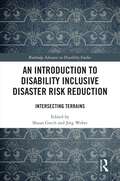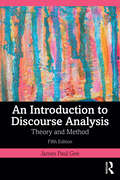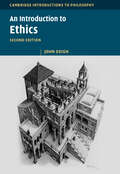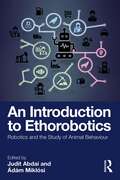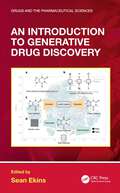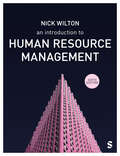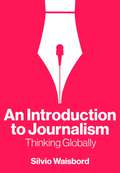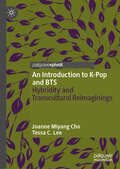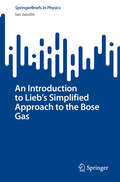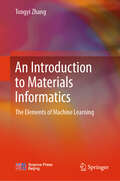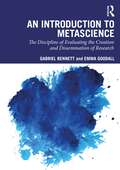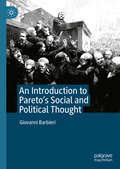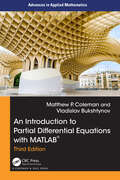- Table View
- List View
An Introduction to Data Analysis Using IBM SPSS
by Lokesh JasraiThis textbook elaborates on the basic understanding and application of statistical tests and data analysis using hypothetical datasets and SPSS version 22.0. It presents step-by-step processes and to-the-point interpretation for quick assimilation and comprehension.Data Analysis Using SPSS Begins with the stages of data entry and goes on till editing and data visualization. Takes the readers through descriptive statistics, frequency, univariate, bivariate and regression analysis, cross-tabulation, linear models and non-parametric test procedures. Presents information through dialog boxes and tabular charts, and also incorporates important formulae, calculations and illustrations of sample data for an in-depth understanding of concepts and results. Can be used as a textbook as well as a reference book as it helps to build conceptual understanding, gaining software skills, and communicates data and its insights to accomplish research assignments, research/capstone projects and PhD research work. With comprehensive coverage, this book would be useful to the students, researchers and teachers of the various social sciences disciplines like Psychology, Sociology, Education, Social Work, Agriculture Management and other allied subjects. It would also be an invaluable companion to professionals and data scientists working in the field of analytics.
An Introduction to Data Science With Python
by Jeffrey S. Saltz Jeffrey Morgan StantonAn Introduction to Data Science with Python by Jeffrey S. Saltz and Jeffery M. Stanton provides readers who are new to Python and data science with a step-by-step walkthrough of the tools and techniques used to analyze data and generate predictive models. After introducing the basic concepts of data science, the book builds on these foundations to explain data science techniques using Python-based Jupyter Notebooks. The techniques include making tables and data frames, computing statistics, managing data, creating data visualizations, and building machine learning models. Each chapter breaks down the process into simple steps and components so students with no more than a high school algebra background will still find the concepts and code intelligible. Explanations are reinforced with linked practice questions throughout to check reader understanding. The book also covers advanced topics such as neural networks and deep learning, the basis of many recent and startling advances in machine learning and artificial intelligence. With their trademark humor and clear explanations, Saltz and Stanton provide a gentle introduction to this powerful data science tool. Included with this title: LMS Cartridge: Import this title’s instructor resources into your school’s learning management system (LMS) and save time. Don′t use an LMS? You can still access all of the same online resources for this title via the password-protected Instructor Resource Site.
An Introduction to Data Science With Python
by Jeffrey S. Saltz Jeffrey Morgan StantonAn Introduction to Data Science with Python by Jeffrey S. Saltz and Jeffery M. Stanton provides readers who are new to Python and data science with a step-by-step walkthrough of the tools and techniques used to analyze data and generate predictive models. After introducing the basic concepts of data science, the book builds on these foundations to explain data science techniques using Python-based Jupyter Notebooks. The techniques include making tables and data frames, computing statistics, managing data, creating data visualizations, and building machine learning models. Each chapter breaks down the process into simple steps and components so students with no more than a high school algebra background will still find the concepts and code intelligible. Explanations are reinforced with linked practice questions throughout to check reader understanding. The book also covers advanced topics such as neural networks and deep learning, the basis of many recent and startling advances in machine learning and artificial intelligence. With their trademark humor and clear explanations, Saltz and Stanton provide a gentle introduction to this powerful data science tool. Included with this title: LMS Cartridge: Import this title’s instructor resources into your school’s learning management system (LMS) and save time. Don′t use an LMS? You can still access all of the same online resources for this title via the password-protected Instructor Resource Site.
An Introduction to Disability Inclusive Disaster Risk Reduction: Intersecting Terrains (Routledge Advances in Disability Studies)
by Shaun Grech Jörg WeberThis first of its kind volume introduces Disability Inclusive Disaster Risk Reduction (DIDRR) in unprecedented critical and interdisciplinary ways covering the complex conceptual, theoretical and practice terrain. Established and emerging scholars and practitioners introduce and probe key discourses, theory, policy and practice at the intersections of disability, disasters and disaster risk reduction, navigating compound and dynamic areas including climate change, governance, wars and conflict, forced migration, disability representation, geopolitics, gender and ethnicity. This edited book lays out and questions established policies, discourses and practices in mainstream areas including Disaster Risk Reduction, Disaster Risk Management and Humanitarian Action, opening an effective critical debate to understand, challenge and shift dominant paradigms. By developing new theory on DIDRR, it will serve as an important tool for academics, researchers and practitioners working in multiple fields including disability studies, disaster management, global health, humanitarian studies, international studies and geography among others.
An Introduction to Discourse Analysis: Theory and Method
by James Paul GeeThis bestselling textbook provides a comprehensive guide to conducting discourse analysis. The book outlines Gee’s approach, which involves examining how language is used in context to construct meaning, identities, relationships, and social practices.The theoretical framework is built around seven "building tasks" that language performs: significance, practices, identities, relationships, politics, connections, and sign systems and knowledge. Gee introduces six "tools of inquiry" for analyzing these tasks: situated meanings, social languages, figured worlds, intertextuality, Discourses, and Conversations.Methodologically, Gee emphasizes the importance of context and the reciprocal relationship between language and context. He discusses transcription, outlines the components of an "ideal" discourse analysis, and addresses issues of validity.The book provides practical guidance on analyzing various aspects of language, such as intonation units, stanzas, and the overall organization of oral and written texts. Gee uses interview data to demonstrate how identities and socially situated meanings are constructed through language.This new edition is updated throughout with new examples and a new chapter on multimodal discourse analysis, demonstrating how Gee’s approach can be applied to texts that combine language with other modes of communication, like images or video. Overall, the book equips readers with a robust toolkit for systematically analyzing discourse.
An Introduction to Diverse Literacies in Primary Classrooms: Perspectives on Pedagogy and Practice
by Karen Daniels Marie HelksHow can teachers be prepared to support all children in becoming literate? How can teachers best mediate the technical aspects of literacy and make these meaningful and relevant to their children? What kinds of pedagogical practices can enable children to become creative and critical users and producers of digital and non-digital texts?An Introduction to Diverse Literacies in Primary Classrooms brings together the voices of academics, classroom teachers, student teachers and children to answer these questions.Research into children's literate lives illustrates that literacy is very much integrated into children's ongoing home, community and school experiences, and these rich and diverse literate lives are very often digitally mediated. This essential and practical book explores key themes in literacy education such as diversity, drama, literacy and play, reader response, grammar and children’s authorship to understand the interrelationship between children’s diverse literacy practices and ways that these can be mediated within the English school curriculum.Written by a team of outstanding ITE English tutors and esteemed literacy researchers, this book is an essential reference for all student and practising teachers, and a must read for literacy coordinators and those interested in literacy research.
An Introduction to Environment, Society and Sustainability
by Paul Sutton Helen HazenThis timely and innovative book delves into the complex interplay of human activities and natural limits in generating today’s sustainability challenges. By contrasting the pressures of growing populations with ecological footprints associated with consumption, the volume navigates the contested terrain where human societies generate environmental impacts.Adorned with illustrative figures, examples and case studies throughout, this book presents insightful analysis of ecological, economic, technological, and social justice responses to the challenges faced by human civilization, including land degradation, climate change, pollution, and overexploitation of natural resources. Many of these issues are wicked problems, characterized by incomplete information, multiple stakeholders, and contested approaches to addressing them. In simple terms, sustainability issues are an interplay between population growth and rising consumption, which are placing impossible demands on finite resources. Potential solutions to the crisis are split between green growth approaches that emphasize technology and institutional capacity to guide economic growth in more sustainable ways, and degrowth approaches that call for a fundamental rethinking of the way we structure society and generate value. This book emerged from a student seminar where undergraduate and graduate students highlighted sustainability topics of concern, helped consider their framing, and then assisted with co-writing several of the chapters. The volume encourages readers to consider structural questions that underpin sustainability dilemmas, and begins with four theoretical frameworks for understanding sustainability issues: ideas from the natural sciences, the population/consumption debate, economic frameworks, and ethical approaches. It then uses a systems approach to apply these theoretical ideas to complex global systems such as the atmosphere, oceans, and agriculture.This volume will be of pivotal interest to students, scholars and academics in the fields of environmental studies, environment and society, human geography and environmental geography, as well as those with an interest in these areas more generally.
An Introduction to Ethics (Cambridge Introductions to Philosophy)
by John DeighNow in an expanded and revised second edition, this book offers clear, penetrating examination of the central questions of ethics through study of the most important ethical theories in Western philosophy. Readers are introduced not only to the main ideas of each theory but also to contemporary developments and defenses of those ideas. Among theories the book covers are egoism, the eudaimonism of Plato and Aristotle, act and rule utilitarianism, modern natural law theory, Kant's moral theory, and existentialist ethics. Two new chapters add to this coverage expositions of Hume's ethics, Sidgwick's program for defending utilitarianism, and Rawls's hypothetical contractarianism. The discussions throughout draw the reader into philosophical inquiry through argument and criticism that illuminate the profundity of the questions under examination. Students will find this book to be a helpful guide to how philosophical inquiry is undertaken as well as to what the major theories of ethics hold.
An Introduction to Ethorobotics: Robotics and the Study of Animal Behaviour
by Ádám Miklósi Judit AbdaiThis pioneering text explores the emerging discipline of ethorobotics which brings together the fields of animal behaviour and robotics. It encourages closer collaboration between behavioural scientists and engineers to facilitate the creation of robots with a higher degree of functionality in animal/human environments and to broaden understanding of animal behaviour in new and intriguing ways.Utilising the knowledge of key ethologists and roboticists in the field today, this book is divided into four major parts. The first part is written for those with little or no background in the biology of animal behaviour, particularly for those coming from an engineering background seeking an accessible introduction to the field and how it can be applied to robotic behaviour. Topics include problem solving in animals, social cognition, and communication (visual, acoustic, olfactory, etc.). The second part is an introduction to the basic construction of robots for non‑engineers, and the possibilities offered by current technical achievements and their limitations to the study of animal behaviour. The third part explores the core theme of ethorobotics, the basic framework of the discipline, the field’s evolution, and current topics including ethical considerations, autonomy, to ‘living’ social robots. The fourth and final chapter looks at ethorobotics in practice through key research projects which have had the biggest impact.This is a ground‑breaking interdisciplinary text which will appeal to upper‑level undergraduates, postgraduates, and researchers focusing on animal behaviour and cognition, as well as those undertaking courses in engineering, social robotics, biologically inspired robotics, AI, and human–robot and animal–robot interactions.
An Introduction to Evidence Science
by Baosheng ZhangThe book discusses the subject and scope of evidence science and puts forward the new epistemological formula of "practice-evidence-knowledge-evidence-practice", which applies to the problem of evidence reasoning and knowledge acquisition that exist in different disciplines. Also, it demonstrates the history of evidence science and reveal the formation, development and maturing process of the traditional evidence theory, as well as the ideological origin and characteristics; clarifies the probabilistic path of judicial proof by probability theory of evidence. It introduces the theory of evidential reasoning, discusses the concept, nature and function the evidential reasoning through chart method, narrative method, the mixed methods and argumentation and story. It puts forward the basic principle in seeking for the truth through evidence-based decision-making. The game-theory rules and models are introduced, as well as the influencing factors of evidence-based decision-making such as fact, evidence, law and claims. It discusses the issues of evidential evaluation in both the general context and legal context, taking the decision-making activities as the frame of reference; discusses the trend of interdisciplinary development of narratology and the resulting “narrative turn” in evidence science through reviewing general theory of narratology. The book introduces the theory of evidential explanation. It analyses the relationships among fact, evidence and explanation from the perspective of hermeneutics; and theory of scientific evidence, discuss the effects of scientific evidence in judicial fact-finding. This book is the research results of the "Evidence Science Theory System and Applied Research" project, which established in 2006 and, after 13 years, has taken a significant first step in the field of a broadly defined evidence science on the basis of a less expansive research endeavor aimed at integrating evidence law and forensic science.
An Introduction to Forensic Phonetics and Forensic Linguistics (Learning about Language)
by Paul Foulkes Ria Perkins Adrian Leemann Grace Sullivan BukerThis textbook provides a practical introduction to the fields of forensic phonetics and forensic linguistics. Addressing how these fields are both distinct yet closely related, the book demonstrates how experts from both fields can work together to investigate and deliver justice in complex legal situations.With pedagogical features including real-life case studies, exercises, and links to further reading, topics covered include:• Profiling from spoken and written texts;• Disputed meaning, and how meaning is made and evolves;• Interviewing techniques, including working around those who might be considered linguistically vulnerable;• Author and speaker determination;• Audio enhancement and authentication of recordings;• Language analysis in the asylum procedure (LAAP).Accompanied by online audio and video resources as well as signposting readers to freely available software to aid their studies, this book is the ideal springboard for students beginning work in forensic phonetics, forensic speech science, forensic linguistics, and law and language.
An Introduction to Fundamentals of Diffusion in Solid State Materials
by Reza GhomashchiDiffusion, the movement of atoms in a material, is an integral part of many metallurgical and materials treatment processes. Understanding diffusion mechanisms helps to control and improve materials properties. This book offers a comprehensive overview of diffusion in the synthesis and analysis of materials (metals and non‑metals) from the fundamentals through applications. Discusses defects in materials, fundamentals of the diffusion process, and different diffusion mechanisms active in metallic alloys Describes diffusion within non‑metallic materials, including ceramics, polymers, and semiconducting materials, with special emphasis on silicon Covers diffusion along high‑energy paths, short‑circuiting diffusion, such as grain boundaries, dislocations, and materials surface Explores diffusion under thermal and electrical gradients and explains how this information is useful for materials purification Details the application of diffusion on carbides during the thermal and thermomechanical treatments of steels Includes problems and solutions for each chapter to reinforce reader’s comprehension Written with less emphasis on complex mathematical equations, this text is accessible to researchers and students in materials, mechanical, and related engineering disciplines studying the phenomenon of diffusion in materials and its application in the engineering of materials.
An Introduction to Generative Drug Discovery (Drugs and the Pharmaceutical Sciences)
by Sean EkinsThis book focuses on the latest advances in computational de novo drug discovery methods, also known as generative drug discovery. This book describes the state‑of‑the‑art methods and applications for de novo design of drug candidates using generative chemistry models as well as the ethical aspects of this technology. It will provide a foundation for those new to the field as well as those that may already have some experience of its utility. With contributions from scientists in both academia and industry ‘an Introduction to Generative Drug Discovery’ may represent one of the earliest if not the first book to focus on this topic. This book focuses on the latest advances in generative discovery methods. This book will describe different state of the art applications of generative molecule design. The book describes ethical aspects of generative drug discovery technology. The mix of academic and industrial authors provides an array of applications of generative drug discovery. A future perspective of where these generative technologies may take us in drug discovery is described included self-driving labs.
An Introduction to Human Resource Management
by Nick WiltonGrasp the fundamentals of Human Resource Management with this engaging and accessible text, ideal for undergraduate and postgraduate students. Covering the key aspects of HRM, this bestselling book will prepare you for the strategic decisions and issues you may face in your HR career. This updated 6th edition includes current discussions on topics such as the gig economy, gender equality and AI and is packed with useful learning features, including: · Case studies from a cross-section of global industries, such as Netflix, Uber and Lego · A running case study throughout, allowing you to relate theory to practice as you solve the challenges faced by the HR Manager of a hotel · ‘HRM in Practice’, ‘Ethical Insight’ and ‘Global Insight’ boxes, which look at HRM in a practical context and stimulate critical debate · Self-test questions and a key terms glossary to allow you to check your understanding as you learn. Nick Wilton is Professor of Applied Human Resource Management, and Associate Dean of People, Accreditation and Reputation, at Oxford Brookes Business School.
An Introduction to Human Resource Management
by Nick WiltonGrasp the fundamentals of Human Resource Management with this engaging and accessible text, ideal for undergraduate and postgraduate students. Covering the key aspects of HRM, this bestselling book will prepare you for the strategic decisions and issues you may face in your HR career. This updated 6th edition includes current discussions on topics such as the gig economy, gender equality and AI and is packed with useful learning features, including: · Case studies from a cross-section of global industries, such as Netflix, Uber and Lego · A running case study throughout, allowing you to relate theory to practice as you solve the challenges faced by the HR Manager of a hotel · ‘HRM in Practice’, ‘Ethical Insight’ and ‘Global Insight’ boxes, which look at HRM in a practical context and stimulate critical debate · Self-test questions and a key terms glossary to allow you to check your understanding as you learn. Nick Wilton is Professor of Applied Human Resource Management, and Associate Dean of People, Accreditation and Reputation, at Oxford Brookes Business School.
An Introduction to Humanitarian Action (Routledge Humanitarian Studies)
by Kristina Roepstorff Katrin RadtkeThis important new textbook provides a concise and practice-oriented introduction to the workings of the humanitarian sector and the key contemporary debates surrounding it.The number of people around the world in need of humanitarian action and protection is at its highest figure in decades; yet at the same time, the humanitarian system is facing numerous problems and undergoing fundamental reforms. This book invites us to tackle these challenges head on, addressing the increasing complexity of humanitarian crises and the implications for humanitarian principles and standards as well as the management of humanitarian projects. Expansive in scope, the book covers: The sector’s historical foundations and the need to decolonise The main types of crises and sectors of humanitarian response State and non-state actors and institutions The key rules, norms, and project management approaches Key trends and challenges, including access, innovation, and anticipation The book also covers important debates on localisation, inclusive programming, and the decolonisation of the humanitarian system. This exciting new textbook will be an important read for students looking for a comprehensive introduction, as well as for practitioners wanting to stimulate critical thinking and enhance their practical skills.
An Introduction to Indigenous Feminisms
by Isabel Altamirano-Jiménez Sarah Nickel Hōkūlani K. Aikau waaseyaa’sin Christine SyAn Introduction to Indigenous Feminisms introduces important concepts and approaches for understanding what Indigenous feminisms are, why we use the term in plural, and why Indigenous feminisms are not just for academics.This engaging and accessible textbook, the first of its kind in this subject, provides instructors and students with the historical contexts, analytical tools, and the practice-driven possibilities for creative and epistemic engagement with Indigenous feminist knowledge. Besides including useful pedagogical features, the volume explores: How Indigenous feminist conversations have evolved What political practices have developed over time Stories, theories, and histories about Indigenous women’s experiences An Introduction to Indigenous Feminisms provides students with ways to practice Indigenous ways of thinking, learning, especially those studying Gender Studies, Social and Cultural History, Sociology and Politics.
An Introduction to Journalism: Thinking Globally
by Silvio WaisbordJournalism remains a vital, irreplaceable institution in the public sphere, even though technology, political and economic trends, and globalization continue to impact it in negative ways.An Introduction to Journalism is the new go-to textbook for journalism studies. Organized around three thematic sections – structures, practices, and change and continuity – this textbook covers a broad range of issues central to the study of journalism. These include the nature of news as a socio-cultural construct; the impact of social forces (political, economic, technology, cultural) on journalistic practices and news content; the origin and the impact of journalistic norms, values, and ideologies; patterns of news access and consumption; the relation between journalism and public life; and the role of the press in democracy and authoritarianism. Taking a global perspective throughout, the textbook is grounded in the conviction that we need to examine developments across countries and regions, and understand how global forces shape news, journalism, and the news industry. Supported by extensive examples and clear case studies throughout, this accessible textbook, written by a leading scholar in the field, provides a comprehensive and analytical survey of the key themes that shape journalism. It is essential reading for undergraduate students of journalism studies.
An Introduction to K-Pop and BTS: Hybridity and Transcultural Reimaginings
by Joanne Miyang Cho Tessa C. LeeThis Palgrave Pivot examines a key area of the Korean Wave or Hallyu, which stands for the global popularity of South Korean popular culture that started in the 1990s. While K-dramas (Korean dramas) have found many viewers throughout Asian countries and some Western countries in recent years, K-pop (Korean popular music) has had broader appeal not only to Asian audiences, but also American (North and South), European, and Middle-Eastern audiences. This book&’s unique contribution is to provide a concise and succinct analysis of K-pop from transcultural perspectives through its most famous example, BTS. The first chapter contextualizes K-pop within the Korean Wave movement. The second and third chapters provide a history of K-Pop, spanning from Seo Taiji and Boys in the early 1990s to the present (including BTS and Blackpink), and presents K-pop as a glocalized phenomenon. The fourth, fifth, and sixth chapters critically examine the most prominent band in the K-pop world, BTS, and the unique connections to their transnational fandom called ARMY.
An Introduction to Lieb's Simplified Approach to the Bose Gas (SpringerBriefs in Physics)
by Ian JauslinThis book explores Lieb's Simplified approach to the ground state of systems of interacting bosons. While extensive research has delved into the behavior of interacting bosons, persistent challenges, such as proving Bose-Einstein condensation, remain. Introduced by Lieb in 1963, the Simplified approach has been the object of renewed attention in recent years, revealing surprising and promising results. Notably, this approach provides ground state energy predictions that agree with many-body systems asymptotically at both low and high densities. It further predicts a condensate fraction and correlation function that agree with Bogolyubov theory at low densities, and numerical predictions match quantum Monte Carlo simulations across all densities. This suggests that Lieb's Simplified approach could serve as a potent tool for reimagining the study of interacting bosons. The book defines Lieb's Simplified approach, discusses its predictions, and presents known analytical and numerical results. It is designed for advanced students and young researchers working in the fields of mathematical physics, quantum many-body physics and Bose-Einstein condensates.
An Introduction to Materials Informatics: The Elements of Machine Learning
by Tongyi ZhangThis textbook educates current and future materials workers, engineers, and researchers on Materials Informatics. Volume I serves as an introduction, merging AI, ML, materials science, and engineering. It covers essential topics and algorithms in 11 chapters, including Linear Regression, Neural Networks, and more. Suitable for diverse fields like materials science, physics, and chemistry, it enables quick and easy learning of Materials Informatics for readers without prior AI and ML knowledge.
An Introduction to Matrix Methods of Structural Analysis
by Muhammad Akram Tahir Worsak Kanok-NukulchaiThe matrix force method has been systematically developed for the analysis of beam and frame structures. It helps develop the matrix stiffness method from a basic spring element, and this is extended to the analysis of beams, trusses, plain frames, grillages, and space frames.Using computer programs (manual, automatic, or the direct force method extending toward automation), this book interactively introduces matrix methods of structural analysis. In addition to work and energy, it also discusses the concepts of stresses, strains, strain displacement relationship, and plain stress and strain. Features: Explains force, displacement, and stiffness via the matrix perspective. Reviews full programming code for each problem. Provides the modern concepts of force method that leads toward automation of the force method, such as the direct stiffness method. Discusses effect of temperatures exclusively. Includes the macro language Matrix Analysis Interpretive Language (MAIL) as an extension of analysis interpretive treatise with examples, exercises, PowerPoint slides, and illustrative problems. The MAIL executable, guide, and codes are provided on the website of the book. This book is aimed at senior undergraduate and postgraduate students in structural engineering.
An Introduction to Metascience: The Discipline of Evaluating the Creation and Dissemination of Research
by Emma Goodall Gabriel BennettAn Introduction to Metascience delves into core metascientific concepts, offering a critical examination of current knowledge creation processes and scrutinising researchers and their methodologies across disciplines.This book stands alone as a comprehensive guide to metascience, offering readers a singular resource for understanding and implementing metascientific principles into their research practices. Readers will find this book invaluable for perfecting their research skills and enhancing the quality of their academic work. It exposes the reader to the intricacies of research processes, prompting a reevaluation of preconceived notions and fostering a deeper understanding of the flaws and solutions inherent in knowledge creation. Furthermore, it offers thought-provoking insights into implementing strategies to enhance research productivity, and it elucidates both the benefits and pitfalls of incorporating artificial intelligence in research production.Designed for scientists and researchers seeking to gain insight into the scientific process, An Introduction to Metascience caters to those interested in understanding how research evolves over time. It appeals to individuals eager to explore methods, practices, and philosophies of science to refine their approach to knowledge creation.
An Introduction to Pareto's Social and Political Thought
by Giovanni BarbieriThis book analyses Pareto&’s social and political thought a hundred years after his death, showing how the structure of the scholar&’s works is generally quite clear (contrary to what is commonly presumed), and how the maintenance of the social and political systems&’ equilibrium represents Pareto&’s main research focus . In particular, the aim of this book is to demonstrate how the author considers the &‘right middle path&’ – in the social, economic, and political arenas – as the only way capable of ensuring social cohesion. The book will be of interest to scholars and researchers of sociology, sociological and political theory, and political science.
An Introduction to Partial Differential Equations with MATLAB (ISSN #27)
by Matthew P. Coleman Vladislav BukshtynovThe first two editions of An Introduction to Partial Differential Equations with MATLAB® gained popularity among instructors and students at various universities throughout the world. Plain mathematical language is used in a friendly manner to provide a basic introduction to partial differential equations (PDEs).Suitable for a one- or two-semester introduction to PDEs and Fourier series, the book strives to provide physical, mathematical, and historical motivation for each topic. Equations are studied based on method of solution, rather than on type of equation.This third edition of this popular textbook updates the structure of the book by increasing the role of the computational portion, compared to previous editions. The redesigned content will be extremely useful for students of mathematics, physics, and engineering who would like to focus on the practical aspects of the study of PDEs, without sacrificing mathematical rigor. The authors have maintained flexibility in the order of topics.In addition, students will be able to use what they have learned in some later courses (for example, courses in numerical analysis, optimization, and PDE-based programming). Included in this new edition is a substantial amount of material on reviewing computational methods for solving ODEs (symbolically and numerically), visualizing solutions of PDEs, using MATLAB®'s symbolic programming toolbox, and applying various schemes from numerical analysis, along with suggestions for topics of course projects.Students will use sample MATLAB® or Python codes available online for their practical experiments and for completing computational lab assignments and course projects.


